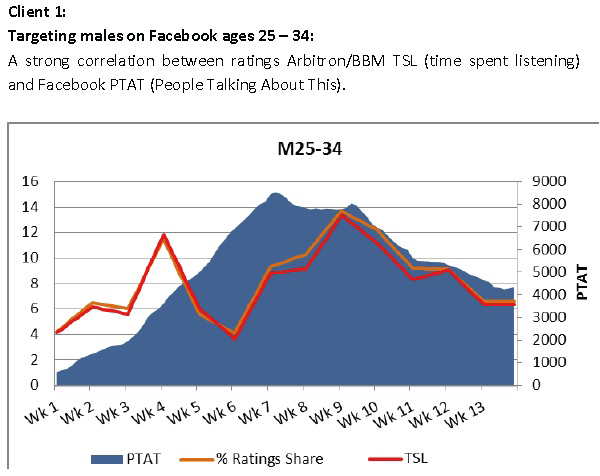
NEW YORK/TORONTO – While there are various social networks, Facebook clearly dominates and can have a direct impact on time spent listening (TSL) and radio ratings. It is not only the undisputed leader in terms of number of active users (1 billion as of October 4th, 2012), but leads in engagement metrics as well. This according to Jumpwire Media, a cross media company specializing in brand strategies for broadcasters and media companies, in their newly released white paper entitled, Social Media Drives Ratings: Examining the Relationships Between Social Media Activities and Ratings.
The report was compiled after an extensive examination of various case studies in broadcasting and social media activities and focused on three main areas of engagement. How Facebook campaigns engage audiences and influences audience development; the relationship between YouTube and radio metrics, and peak times for Twitter activity.
Results were aggregated from multiple stations across North America to illustrate common trends including the isolation of results stemming from existing advertising and marketing campaigns. Results were tested using Jumpwire Media system of aggregating results.
“Americans spend the equivalent of 100,000 years on Facebook each month. Twitter, tumblr and Pinterest may be growing in popularity but clearly do not compete with Facebook in terms of time,” reports Jumpwire.
It found that user engagement on Facebook can have a “direct impact on time spent listening (TSL) and radio ratings, depending on the demographic.”
To quantify the engagement, “People Talking About This” (PTAT) was measured. Facebook’s PTAT creates awareness of a brand and therefore promotes trial and/or continued usage, which in turn affects TSL and ratings says Jumpwire.
“PTAT is the number of unique users who have created a story about a page in a seven-day period. Users create stories in various ways: ‘likes’ a page, posts on the page wall, ‘likes’ a post, comments on a post, shares a post, answers a question, RSVPs to a page’s event, mentions the page in a post, tags the page in a photo, check?ins at a place or recommends your place,” states the report.
The graphs displayed here overlay the weekly ratings share and TSL on top of the PTAT levels of the company’s radio clients against different demographics. Multiple radio clients and audience demographics were examined, showing that some audience demographics have a stronger correlation with PTAT and radio performance than others. The ramping up of the PTAT levels (in blue) occurs when the Jumpwire Media system started to get implemented.

Of its six case studies it found most demographics have a correlation between PTAT, ratings and TSL, with males and females 25 – 34 exhibiting the strongest linkage. All others, except for females 35 – 44, show multiple periods of correlation and/or lag effects whereby rating and TSL levels lag PTAT levels.

“We at Jumpwire Media have a single-minded focus on achieving measurable results for our clients. We have proven after 18 months of extensive study using our systems, the importance of social media activity to the future of radio broadcasting. By implementing even just four initiatives, broadcasters can improve and increase their audience ratings and audience engagement," said Gavin McGarry, Founder of Jumpwire Media.
White paper findings include:
- Facebook activities drive radio ratings when photos are the key content posted.
- Unique differences between U.S. and Canada in Twitter usage. U.S. market does not take advantage of morning and afternoon drive commuter hours whereas radio stations in Canada do
- The best time to tweet for radio stations is on Fridays
- Radio stations have an inherent YouTube advantage that is not being exploited: celebrity interviews helping to drive video views via proper tagging
- Tracking Facebook and Twitter performance metrics can identify content before it goes viral.
How to improve a radio station’s social media performance:
- Develop key media platforms to own which can build engagement. Concentrate on Facebook, YouTube, Instagram and Twitter
- Consider the type of content that is posted. Pictures work well on Facebook, local news on Twitter and celebrity interviews on YouTube
- Track the data. The strength of digital media is that everything can be measured. Decide what the key performance indicators are and set up a system to mine the data for trends and insights that can help future efforts
- Social media is not a department it’s a skill set that needs to be cultivated throughout the organization.



